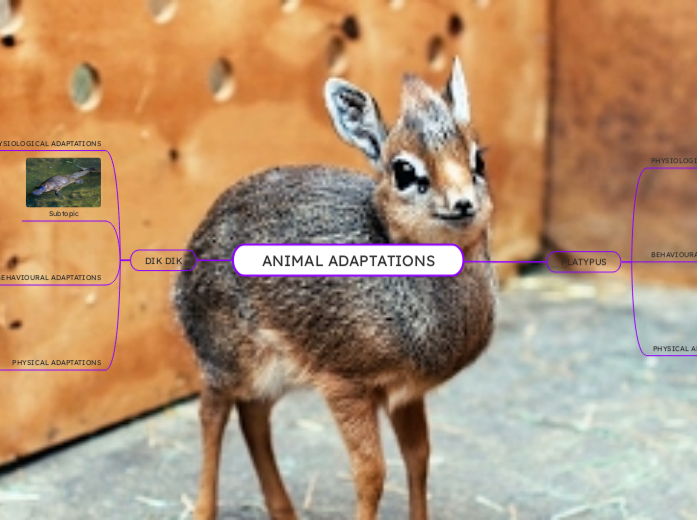ANIMAL ADAPTATIONS
PLATYPUS
PHYSIOLOGICAL ADAPTATIONS
A Platypus propels itself through water using its
front legs and sometimes rear legs as a rudder to swim through the water. A platypus does have a lot of red blood cells, in scientific terms its called a high Corpuscular Hemoglobin Concentration (MCHC). Hemoglobin is iron - rich protein. Hemoglobin is also responsible for circulating oxygen throughout the body. Male platypuses have a spike that injects from the rear leg.
BEHAVIOURAL ADAPTATIONS
A Platypus is mainly an aquatic animal but it can breathe air unlike some aquatic animals. Platypuses build their burrows in soft riverbanks because burrows act like a home and is also the place where most female platypuses lay their eggs.
Subtopic
PHYSICAL ADAPTATIONS
A Platypus's physical adaptations are it's
stream line body, its broad and flat tail. The colour of the platypus is brown. The texture of its skin is smooth and furry, it has a soft bill, and four webbed feet.
DIK DIK
PHYSIOLOGICAL ADAPTATIONS
When dik diks have conserved their urine, instead of urinating they will sweat out all of the water they drank. Dik Diks also have an altered body temperature meaning the body temperature of a dik dik is unstable. Dik Diks also actively sweat which can cause diseases like: fever, malaria, menopause, leukemia, and many more.
Subtopic
BEHAVIOURAL ADAPTATIONS
In order to survive through the hot climate a dik dik has to conserve the water it drank and concentrates the most urine out of all ungulates. The reason dik diks do that is so that they don't have to drink water for long periods. When dik diks are startled they will run in away in a zig zag line.
PHYSICAL ADAPTATIONS
A Dik Dik has a has a long but thin snout
the snout is used to keep the dik dik's body cool because of the hot climate in its habitat.
A dik dik has a gland in front of its eye discharging
a stick and black fluid. Male dik dik's have thick hair and horns at the top of their head. It's fur is smooth and soft with light brown tone.
